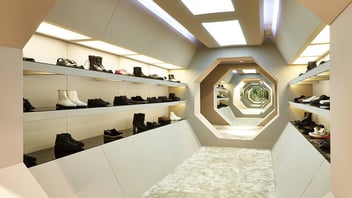Mobile self-scan: Unleashing the power in your customers' pockets
Why empowering customers to use their own devices to scan and shop will help build customer loyalty, boost sales, and reduce costs
By Andrew Gorecki, Managing Director at Retail Directions
Walk into many retail stores – especially supermarkets – and you’re often faced with a rack of handheld self-scanner units, supposedly put there to empower the customers and reduce their need to interact with the store’s staff. Looks like a good idea.
But at what cost to the retailer?
This strategy demands high initial investment plus ongoing costly maintenance of such scanning systems. The scanning devices are a bit more fragile than shopping trolleys, so they can be easily damaged or even stolen. In a nutshell, the retailer must incur considerable extra cost and the question has to be asked whether enough benefit can be gained from such an investment.
Essentially, customers can use the devices to scan their goods, pay, and leave quickly. Such benefits fall into a soft category, enhancing the brand perception, with questionable hard savings. In my view, retailers still need the soft benefits, but if they could get them without the cost, this would be vastly superior.
The self-scanning devices still continue to form part of a trend that has seen “explosive growth” according to the latest figures from research company RBR.
The number of stores allowing customers to scan as they shop grew by nearly a quarter globally last year with 57,000 stores now offering mobile self-scanning, up 11,500 in 2022 – a number expected to triple by 2027. One has to ask the question: how can retailers handle the cost side of this trend?
The smartphone alternative
The industry increasingly applies the easy answer: don’t provide customers with scanners. A cheaper, more accessible alternative to retailer-owned devices already sits in customers’ pockets. An alternative that enables the same benefits of improving the customer experience in-store but with minimal cost.
Offering mobile self-scanning through customers’ smartphones allows greater penetration of the mobile scan-as-you-shop market at a much lower cost. This makes it possible for the use of mobile self-scan to extend beyond supermarkets into other retail sectors, as well as into new regions.
Where the self-scan market was once dominated by the grocery sector, more than a third of the stores now offering mobile self-scanning globally operate in non-grocery space according to the RBR report.
In the UK the likes of M&S and IKEA allow customers to use their own devices to mobile self-scan. With the technology now well-proven, it’s time for other retailers to realise its advantages and benefit from its power and opportunity.
Why you too should be tapping into the power of your customers’ own devices
To encourage customers to unleash the power in their pockets, retailers first need to understand the problem they can solve for them – and then clearly communicate the benefits to the consumer.
That can be a challenge in itself, as although the benefits of mobile self-scan are wide-ranging, they can be subtle. And, more significantly, vary from brand to brand.
The ‘Scan and pay’ component of the shoppers’ experience has been one of the main factors driving supermarket adoption of the technology for consumers who want to shop and go. But much greater opportunities exist in other retail sectors, around using such technology to build the brand experience and encourage deeper engagement with the technology beyond just scan and pay.
It shouldn’t just be about getting customers in and out of your stores as fast as possible, instead, it offers the chance to offer a richer unified commerce strategy and brand experience.
For customers, mobile self-scan allows empowerment and a richer experience with your brand. Customers can check stock levels, view different colours, sizes, or styles available elsewhere in the store or local stores, or be targeted with special promotions and experiences, in addition to functionality such as add-to-basket, bust the queues, and pay.
Mobile self-scan can be a useful tool and information source for customers who may want to find out more for themselves, rather than find a store assistant to ask. This means it can work just as well in a high-touch retail environment as a low-touch one. Equally, the ability to self-serve when the customer chooses to doesn’t replace the role of the store assistant, but is simply another valuable option in your brand experience tool-kit, helping to create ‘brand stickiness’ that in turn drives loyalty.
And this means a big opportunity.
According to RetailDive, nearly three-quarters (73%) of customers favour self-service technologies that help to improve the retail shopping experience and reduce staff interactions. As retailers, you need to offer your customers the choice of how they interact with your staff.
In addition to improving efficiency in-store, it positions the retailer as forward-thinking and experience-driven. And of course, it also saves expenditure on that big hardware device investment we mentioned earlier.
How can retailers help to unleash the power in their customers’ pockets?
So how can you implement mobile self-scan in-store?
Many retailers offer such functionality through their own apps, but in an app-weary world this can be another barrier to adoption. Also, such apps usually extend your website to consumer devices, while at the store level, we need the system to extend the store’s POS system into the consumer’s device.
A viable alternative, and one which offers greater benefits because the customer doesn’t need to download a specific app or endure cumbersome app updates, relies on a web-based app hosted by the retailer. In this case, all the customer needs to do is scan an in-store QR code which activates the mobile self-scan functionality on their devices. The QR code also tells the system which stores the customer just entered.
Retail Directions’ Electronic Virtual Assistant (eVA) enables exactly that. It operates as a browser-based, OS-independent web app that will run on any mobile device as long as it’s running a browser and connects to the local store system over a 4G/5G network. It provides you with a valuable extension of your store services, allowing you to increase the willingness of the customer to make a purchase directly in-store rather than online.
And it works simply by accessing your Retail Directions point of sale system, providing your customer with all the information they may need. Mobile scan as you shop isn’t a revolutionary technology but it augments what you already have and allows you to provide a smoother in-store experience.
At a time when the hunt is on for how to strengthen your brand at low cost then mobile self-scan is an obvious and cost-effective solution that more retailers and brands need to adopt. If you want to be one of them then contact us to find out more about how Retail Directions eVA can help.
ENDS
The Retail Directions Mobile Self-Scan tool is part of the Retail Directions retail management platform. Find out more here.

.png)




